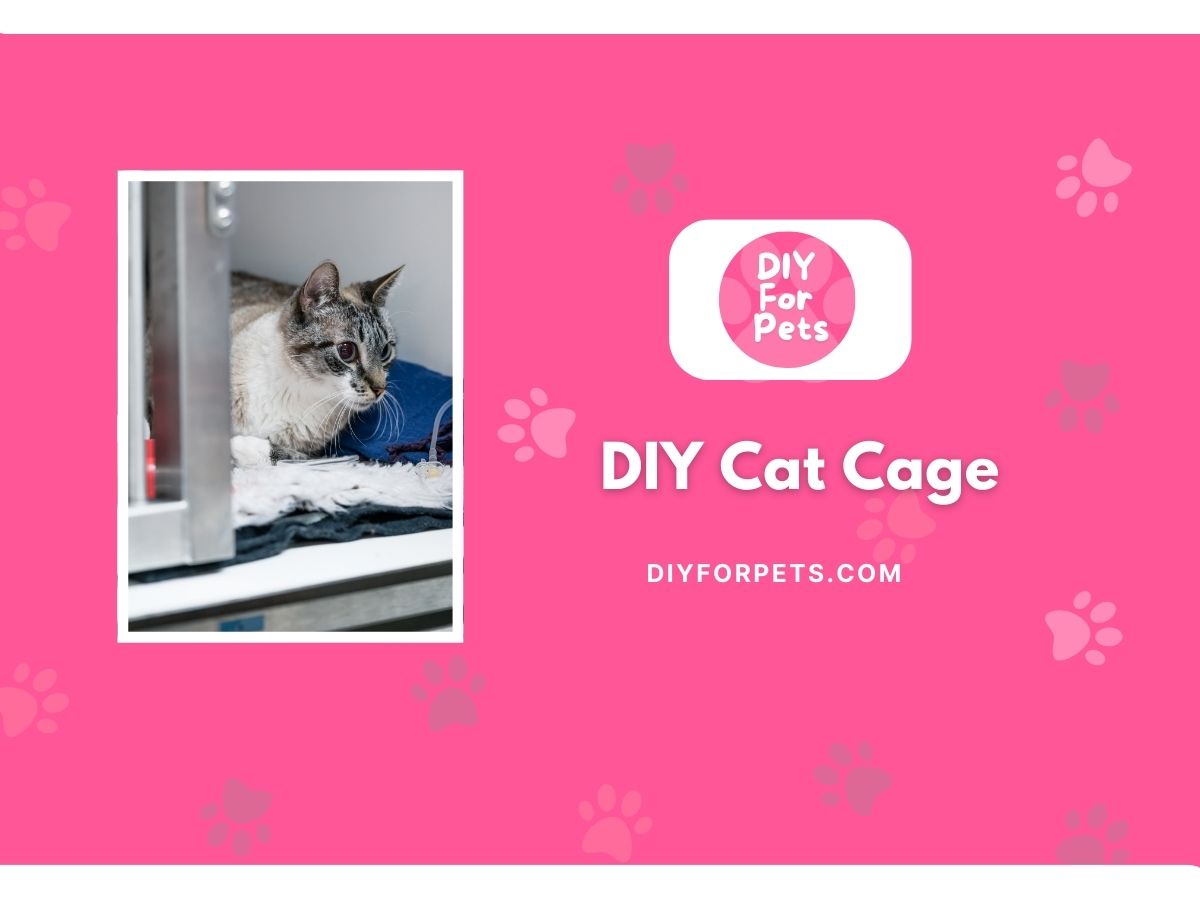7 DIY Cat Cage For A Comfortable Living (Easy To Build)
With a house full of pets—rabbits, dogs, and, of course, my curious cats—I’ve found that sometimes, a cat cage or enclosure is incredibly useful. Unlike cages for other pets, a cat cage isn’t about confinement but rather creating a safe, secure space for them. Whether it’s for travel, introducing a new cat, or giving them a quiet retreat, a DIY cat cage can be a budget-friendly way to cater to their needs while keeping them comfortable.
Do Cats Need Cages Similar to Dogs?
Unlike dogs, cats don’t typically need cages for discipline or training. However, a cage or a secure enclosure can come in handy in specific situations. For example, if you’re introducing a new cat to your household, an enclosed space allows for a slow, safe introduction. It can also be helpful for travel, visiting the vet, or even as a cozy retreat when things get too chaotic in the home (which, with multiple pets, happens a lot here!). The key is to create an inviting space rather than a restrictive one, so the cat sees it as their own little nook rather than a confinement.
DIY Cat Cage: Step by Step
Making a DIY cat cage is surprisingly easy, with most materials being things you might already have around the house. Let’s go through a basic setup, along with some unique ideas to customize your cat’s cage according to their personality and needs.
Materials Needed
- Sturdy plastic or metal panels: $15–$25
- Zip ties or connectors: $5–$10
- Soft blanket or small bed: $5–$10
- Mesh or clear plastic sheets (optional): $5–$8
- Basic tools (scissors, utility knife, etc.): Already have this!
Total cost: Around $20–$35, depending on the size and materials you choose.
Phase 1: Building the Frame
Start by setting up the frame of your cage. Using plastic or metal panels, create a rectangular or cube-shaped frame, securing each panel together with zip ties. If you prefer a more open concept, you can leave one or two sides as open mesh or even use flexible fencing material.
Phase 2: Adding Comfort and Security
Line the base of the cage with a soft blanket or small bed to make it comfortable. Adding a familiar blanket or a piece of your clothing can make the space feel cozy and inviting.
Phase 3: Personalizing the Space
Add a few toys, a scratching post, or even a small ledge for them to perch on. This is where you can make the cage feel like more of a cozy den than a cage. I like adding a small towel over one side to give my cats a little privacy, which they seem to appreciate.
Easy DIY Cat Cage Ideas
Here are some creative and easy DIY cat cage ideas that will give your cat a safe space to relax, explore, or simply observe the world.
1. Portable Mesh Cage
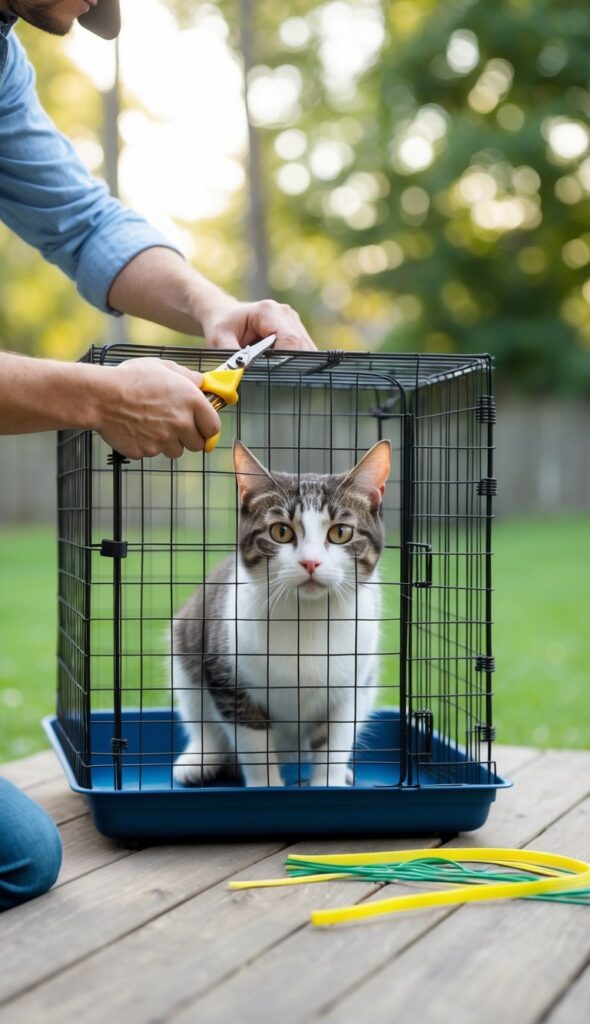
For a temporary or portable cage, you can use a foldable mesh laundry hamper as a lightweight and breathable option. These hampers are already enclosed on all sides with mesh, allowing for airflow and visibility. Simply place a small blanket and a toy or two inside, and it’s an instant cozy nook for your cat. This is great for travel or outdoor use since it’s so easy to pack up and move.
This cage option costs around $10 and is perfect for temporary use, such as trips to the vet or outdoor adventures. It’s compact, easy to clean, and super light.
2. Plastic Storage Bin Cage
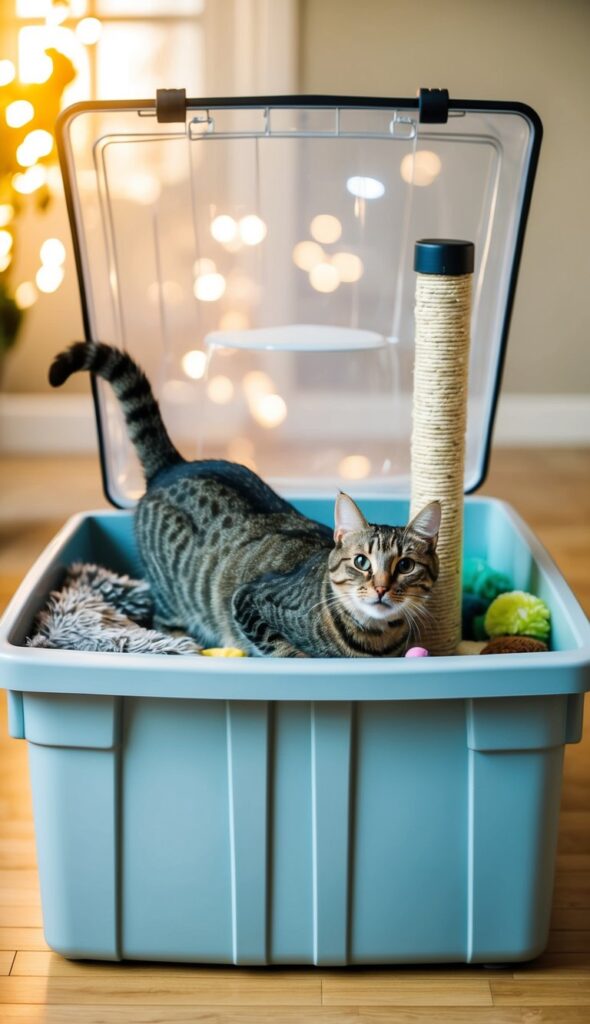
For a more secure, semi-permanent cage, try using a large plastic storage bin. Drill or cut ventilation holes along the sides, cover the bottom with a soft blanket, and add a few toys. This setup is excellent for introducing a new cat to your home, as it provides enough space while keeping them contained.
The average cost is around $15, making it an affordable, sturdy option for cats who need a quiet space during introductions or travel.
3. Wire Shelf Enclosure
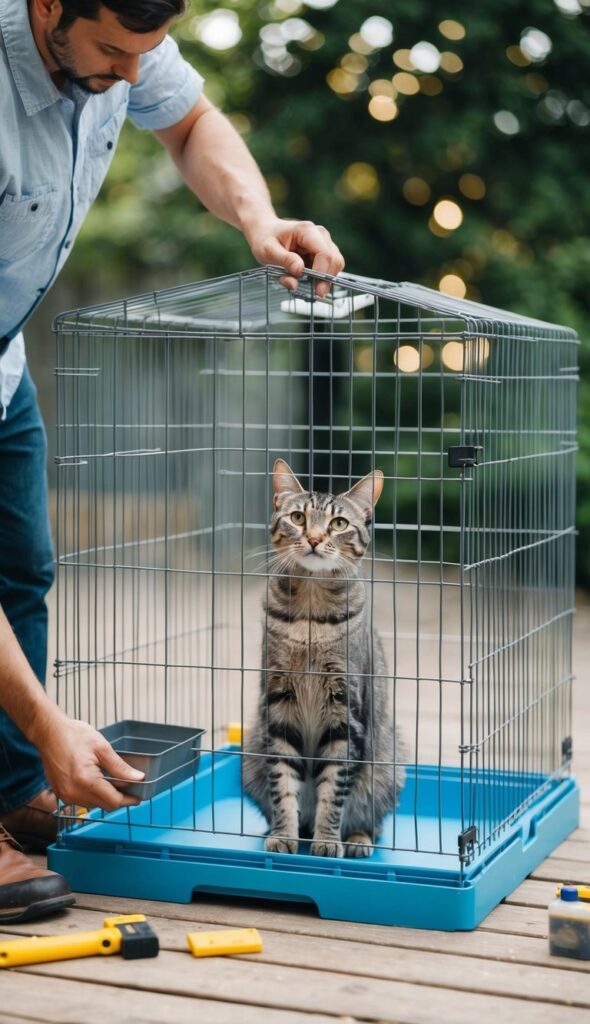
If you have wire storage shelves lying around, they can be easily converted into a multi-level cat cage. Stack the shelves and secure them with zip ties or connectors, creating an open but enclosed space. You can add shelves or panels as platforms, allowing your cat to climb and explore vertically.
This project costs around $20, especially if you already have the shelving. It’s ideal for active cats who love climbing, as the shelves can act as both a bed and a perch.
4. Cardboard Box Condo
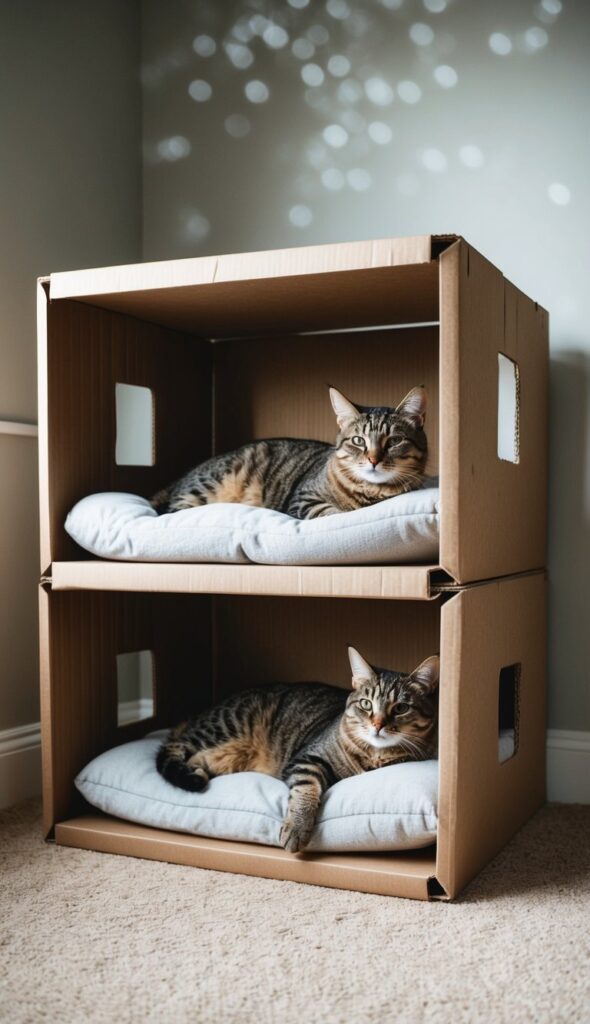
This is one of my favorites and the easiest on the budget! Stack and tape several cardboard boxes together to create a multi-level structure, cutting doors and windows for entry and ventilation. Line each level with a towel or small blanket. Cats love hiding in boxes, so this setup feels natural for them.
The cardboard box condo is free if you have boxes around, and it’s a fun, temporary structure that you can easily replace or customize as needed.
5. PVC Pipe Cage
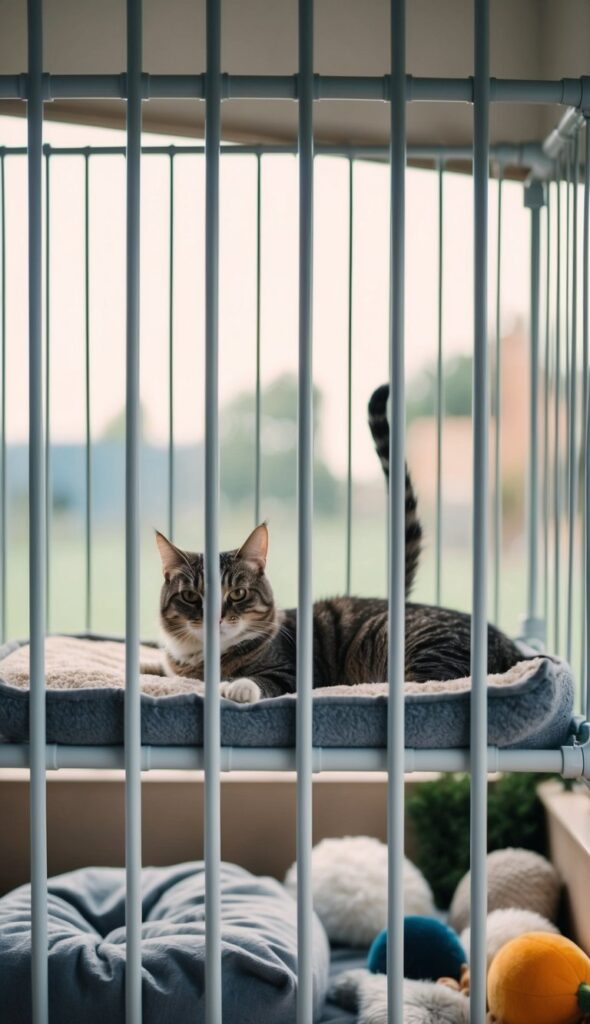
For a durable and weather-resistant cage, consider building one from PVC pipes. Use PVC connectors to form a frame, covering the sides with mesh or netting for ventilation. Add a soft bed or blanket at the base. This cage is suitable for both indoor and outdoor use, and it can be as small or large as you like.
This project costs about $25 and requires a bit more effort, but it’s ideal for anyone looking for a more permanent outdoor solution for their cat.
6. Repurposed Dog Crate with Cat Platforms
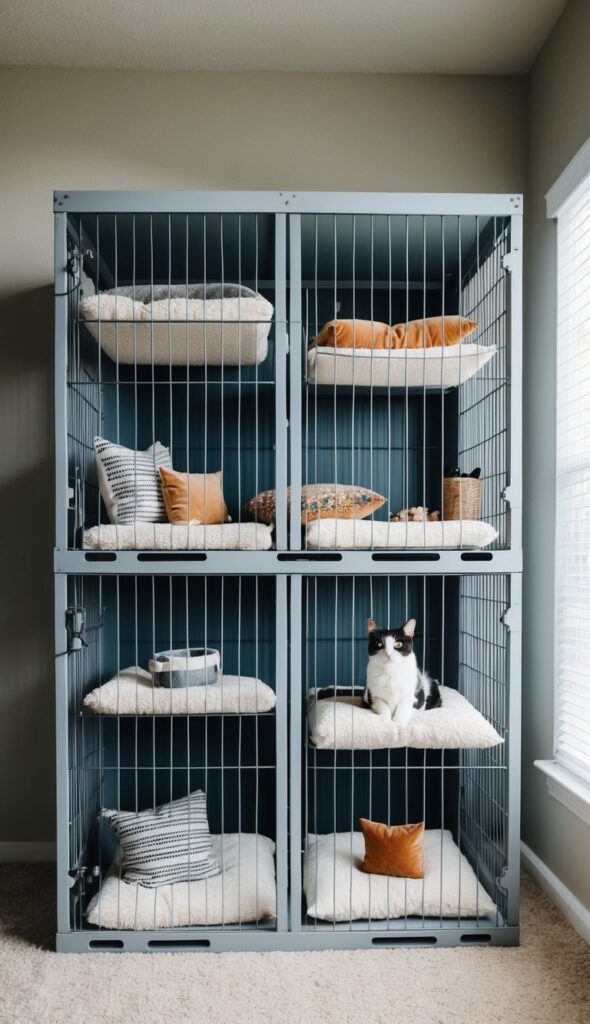
If you have an old dog crate lying around, repurpose it by adding platforms or small ledges inside for your cat to jump onto. Line the base with a blanket or bed, and add a towel over part of the top for some extra privacy. This setup works well for households with multiple pets, as it allows your cat a safe retreat while still being part of the action.
The cost for this project is around $5 if you already have a crate. It’s perfect for creating a cozy retreat within a shared space, allowing cats a bit of privacy without feeling isolated.
Dos & Don’ts in Cat Cages
- Do: Place the cage in a quiet, familiar area to help your cat feel secure.
- Do: Include bedding and toys to make it a welcoming space.
- Don’t: Use the cage as punishment; make it a positive environment.
- Do: Add ventilation to prevent overheating, especially for closed cages.
- Don’t: Leave your cat in the cage for extended periods—cages should be used temporarily or as a retreat.
FAQs
1. How long can I keep my cat in a cage?
Cats shouldn’t be kept in cages for long periods. The cage is meant as a temporary, safe space for introductions, travel, or naps.
2. What’s the best location for a cat cage?
Place the cage in a quiet, familiar area of your home. Cats like observing their surroundings, so near a window can also be a great choice.
3. Can a DIY cat cage be used for travel?
Yes, especially portable options like the mesh hamper or storage bin. Just make sure it’s secure and ventilated for the duration of the trip.
4. Should I put food and water in the cage?
For longer stays or travel, include water, but avoid placing food if it’s just a short rest area to keep it clean.
Creating a DIY cat cage has turned out to be more practical and fun than I expected. Not only does it give my cats a personal space to retreat to when they want some quiet time, but it also allows me to be flexible and creative. So, whether you’re setting it up for a new kitten, travel, or just a cozy retreat for your cat, these DIY cage ideas make it easy, affordable, and tailored to your cat’s comfort.

